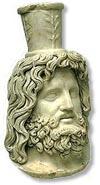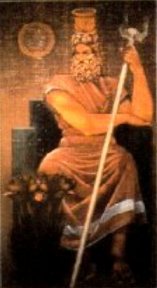Serapis

Serapis

Ptolemy I Soter, the first
of the Macedonian kings to rule Egypt (323-283 BC), introduced a new god to
provide Alexandria with a patron deity and unite the Greek and Egyptian population
of the city. This new god was derived from the Egyptian god Osiris and the Apis
bull. The Apis-bulls ,who where worshipped in Egypt as reincarnations of the
god Ptah, were mummified and buried upon their death after which they where
made immortal by Osiris and became Osiris-Apis. A manifestation of the apis
bull and the Egyptian god of the underworld Osiris.
As a sort of reincarnation of the
once popular god Osiris the new god became an immediate hit with the native
Egyptians but also with the Greeks who first called him Hades (to which Serapis
bears a great resemblance) but pretty soon they started using a Greek form of
the Egyptian name and the god became widely known as Serapis. An elaborate temple
was built in Alexendria containing a huge statue of Serapis made of all different
kind of stones, precious metals and gems, the so called Serapeum. The cult was
actively promoted throughout the Mediterranean world. Serapis, being a manifestation
of the underworld god Osiris, was just like Hades accompanied by a three headed
dog who looked a lot like Cerebrus the guardian of the Greek underworld. The
new version looked like a snake wrapped around a dogs body with the heads of
a wolf a dog and a lion. Serapis could take the form of a bull (just like Osiris)
or the form of a human with a bulls head.

In 391 the Serapeum in Egypt
was ordered to be destroyed by the emperor Theodosius.
After his degree, which forbade the worship of pagan gods and which elevated
Christianity as the state religion of the roman empire, religious riots broke
out in Alexandria between Christians and worshippers of Serapis who had barricaded
themselves in the huge temple. As revenge for this degree they sacrificed captured
Christians to their god who where promptly declared marters by Theodosius. Although
the temple was eventually destroyed, the pagans were offered mercy and set free.
After this the cult of Serapis slowly faded away. Serapis appears sparingly
on imperial coins but more frequently on provincial coins.